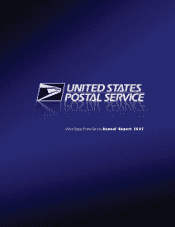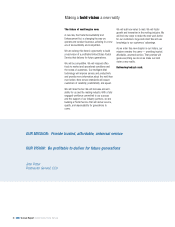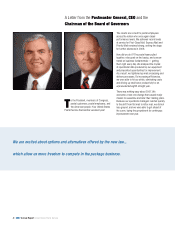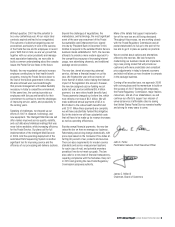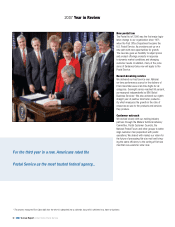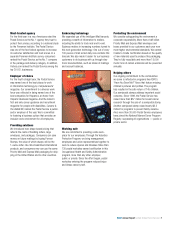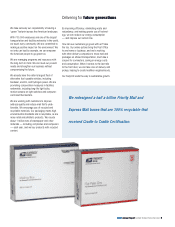US Postal Service 2007 Annual Report Download - page 5
Download and view the complete annual report
Please find page 5 of the 2007 US Postal Service annual report below. You can navigate through the pages in the report by either clicking on the pages listed below, or by using the keyword search tool below to find specific information within the annual report.
2007 Annual Report United States Postal Service | 52007 Annual Report United States Postal Service | 5
Without question, 2007 had the potential to
be a very contentious year. All our major labor
contracts expired and had to be renegotiated.
The outcome of collective bargaining was not
preordained, particularly in view of the success
of the Postal Service and its employees in recent
years. With that in mind, we are very proud that,
together with our union presidents and manage-
ment association leadership, we were able to
build a common understanding about the complex
issues the Postal Service faces in the future.
Notably, the new negotiated contracts increase
employee contributions to their health benefit
programs, moving the Postal Service closer to
the rest of the federal government in this area.
We also achieved work rule breakthroughs
that provide management with added flexibility
necessary in today’s competitive environment.
At the same time, the contracts provide our
employees with fair pay and benefits for their
commitment to continue to meet the challenges
of improving service, safety, and productivity in
the coming years.
Speaking of challenges, we stepped up our
efforts in 2007 in research, technology, and
new equipment. The Intelligent Mail Barcode will
offer mailers improved service quality, visibility,
and cost data about individual mailings that was
never before available, while increasing efficiency
for the Postal Service. Our plans call for full
implementation of the Intelligent Mail Barcode
in 2009. And the upcoming deployment of the
automated Flats Sequencing System is another
significant tool for improving service and the
efficiency of our processing and delivery systems.
Beyond the challenges of negotiations, the
marketplace, and technology, the most significant
event of the year was enactment of the Postal
Accountability and Enhancement Act, signed
into law by President Bush in December 2006.
Drafted to respond to the outdated Postal Service
business model established in 1970, the new law
attempts to provide a more modern approach to
the competitive pressures of increasing Internet
usage, new advertising channels, and traditional
package service providers.
The new law, aimed at preserving universal
service, did have a financial impact on us this
year. We finished the year with an income of
more than $1.6 billion, before taking the financial
impact of the legislation into account. However,
the new law assigned escrow funding we set
aside last year, and an additional $5.4 billion
payment, to a new retiree health benefits fund.
Those payments changed our bottom line, which
now reflects a net loss of $5.1 billion. We will
make additional annual payments of $5.4 to
$5.8 billion to the retiree health benefits fund
until 2017. When these payments are complete,
we will have substantially funded this obligation.
But in the interim we will bear substantial costs
that will have to be made up by revenue increases
as well as operating efficiencies.
Besides annual financial payments, the new law
raises the bar on how we manage our business.
Ratemaking and pricing change dramatically, with
price caps based on the Consumer Price Index af-
fecting 90 percent of our products and services.
There are also requirements for modern service
standards and service measurement systems
for each class of mail, and potential monetary
penalties if we do not meet our goals. The law
also calls for a new level of financial transparency,
requiring compliance with the Sarbanes-Oxley Act
in 2010 and granting the new Postal Regulatory
Commission subpoena authority.
Many of the details that support implementa-
tion of the new law are still being developed.
Throughout this process, we are working closely
with the Postal Regulatory Commission and all
postal stakeholders to live up to the spirit of the
law and to get it in place as quickly as practical.
We are excited about options and alternatives
offered by the new law. We look forward to
modernizing our business model and implement-
ing a new pricing model that will provide our
customers with more predictable and consistent
price adjustments in today’s dynamic economy
and which will allow us more freedom to compete
in the package business.
Coming off an excellent year, we approach 2008
with a strong base and the momentum to build on
the success of 2007. Working with employees,
the Postal Regulatory Commission, major mailers,
consumers, and all of our stakeholders, we will
continue our efforts to support our mission of
universal service at affordable rates by seeing
that United States Postal Service remains healthy
and strong for many years to come.
John E. Potter
Postmaster General, Chief Executive Officer
James C. Miller III
Chairman, Board of Governors

